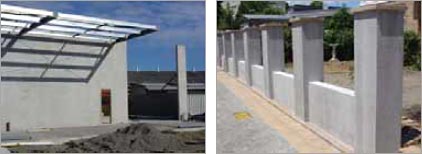Resene Popular Paint Systems –
Concrete, plasters and cement-based substrates: training notes
This web page is an edited version of the Resene Best System Selling training notes provided to Resene staff and is provided to enable you to gain a greater understanding of the substrates and paint systems you may encounter in your decorating project. It is impossible to cover all decorating scenarios in a single document, so if you are in doubt about any aspect of your project please contact Resene for assistance.
Select the substrate you will be painting from the list below to view how to prepare and finish the surface.
Preparation flowcharts
Topcoat systems flowcharts
(Preparation)
Note: Refer to the PDF flowchart for a visual of the steps below:
Wash down with Resene Paint Prep and Housewash to remove dirt, oils and other contaminants.
Fill cracks and voids:
Prime using Resene Concrete Primer.
Refer to topcoat systems flowcharts.
NOTE: Resene Limelock may be used on new concrete and plaster to enhance the cure and hold back limestaining. It is most effective when applied during the construction stage.

Concrete (and thickly applied plasters) may take up to 28 days to fully cure and, unless Resene Limelock is used, should not be painted before this time.
Curing and release agents will need to be removed from concrete before painting. In most cases Resene Paint Prep and Housewash will do the job, but for stubborn release agents a stronger product like Resene Emulsifiable Solvent Cleaner should be used. This is rarely an issue for DIY paint users (see appendix).
Plasters, masonry finishes and cement sheets will collect dust and air-blown contaminants, such as salt, on the surface. A thorough wash and hose down should be sufficient to remove plaster dust etc. from the surface.
Concrete will sometimes have minor cracks and bug holes. These are best filled with plaster, such as Rockcote Multistop, or alternatively an epoxy, such as Resene Epox-O-Bond. Use a spatula or 35-50mm broad knife.
Plasters and masonry may have small hairline cracks caused as the plaster dries. It is often difficult due to the rough nature of the surface to use a filler, so use Resene Brushable Crack Filler or Resene X-200 brushed into the cracks.
Apply Resene Concrete Primer before filling any cracks or voids.
Resene Limelock is recommended for new plasters and masonry. Resene Concrete Primer will help prevent subsequent limestaining. When dark colours are used, allow at least 7 days before overcoating Resene Limelock.